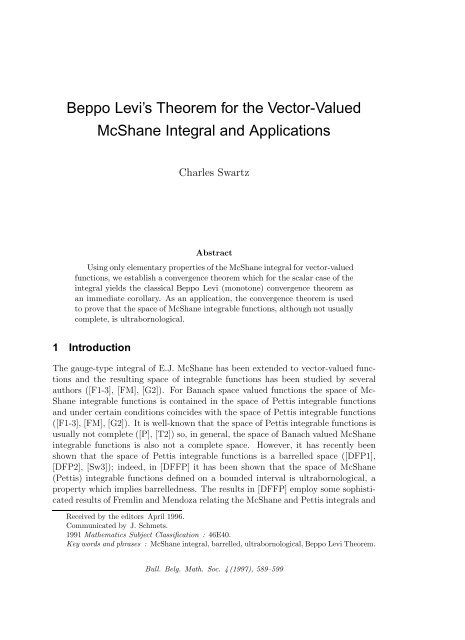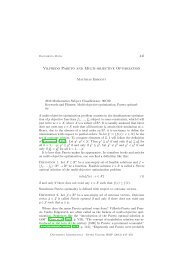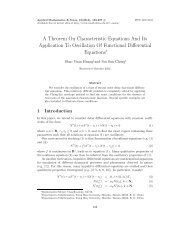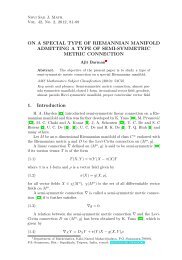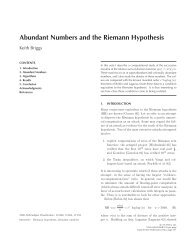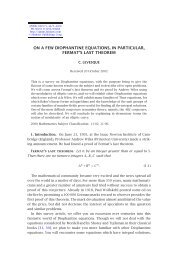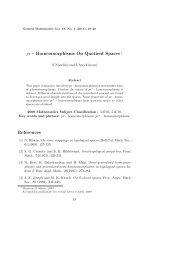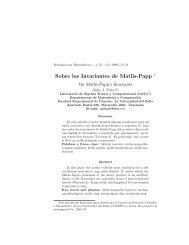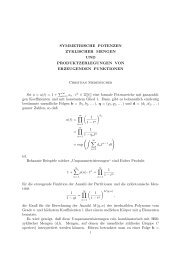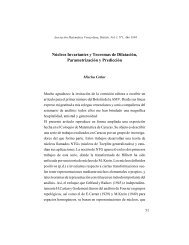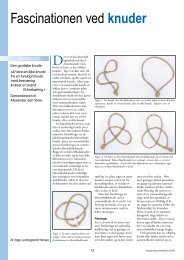Beppo Levi's Theorem for the Vector-Valued McShane Integral and ...
Beppo Levi's Theorem for the Vector-Valued McShane Integral and ...
Beppo Levi's Theorem for the Vector-Valued McShane Integral and ...
You also want an ePaper? Increase the reach of your titles
YUMPU automatically turns print PDFs into web optimized ePapers that Google loves.
<strong>Beppo</strong> Levi’s <strong>Theorem</strong> <strong>for</strong> <strong>the</strong> <strong>Vector</strong>-<strong>Valued</strong><br />
<strong>McShane</strong> <strong>Integral</strong> <strong>and</strong> Applications<br />
Charles Swartz<br />
Abstract<br />
Using only elementary properties of <strong>the</strong> <strong>McShane</strong> integral <strong>for</strong> vector-valued<br />
functions, we establish a convergence <strong>the</strong>orem which <strong>for</strong> <strong>the</strong> scalar case of <strong>the</strong><br />
integral yields <strong>the</strong> classical <strong>Beppo</strong> Levi (monotone) convergence <strong>the</strong>orem as<br />
an immediate corollary. As an application, <strong>the</strong> convergence <strong>the</strong>orem is used<br />
to prove that <strong>the</strong> space of <strong>McShane</strong> integrable functions, although not usually<br />
complete, is ultrabornological.<br />
1 Introduction<br />
The gauge-type integral of E.J. <strong>McShane</strong> has been extended to vector-valued functions<br />
<strong>and</strong> <strong>the</strong> resulting space of integrable functions has been studied by several<br />
authors ([F1-3], [FM], [G2]). For Banach space valued functions <strong>the</strong> space of Mc-<br />
Shane integrable functions is contained in <strong>the</strong> space of Pettis integrable functions<br />
<strong>and</strong> under certain conditions coincides with <strong>the</strong> space of Pettis integrable functions<br />
([F1-3], [FM], [G2]). It is well-known that <strong>the</strong> space of Pettis integrable functions is<br />
usually not complete ([P], [T2]) so, in general, <strong>the</strong> space of Banach valued <strong>McShane</strong><br />
integrable functions is also not a complete space. However, it has recently been<br />
shown that <strong>the</strong> space of Pettis integrable functions is a barrelled space ([DFP1],<br />
[DFP2], [Sw3]); indeed, in [DFFP] it has been shown that <strong>the</strong> space of <strong>McShane</strong><br />
(Pettis) integrable functions defined on a bounded interval is ultrabornological, a<br />
property which implies barrelledness. The results in [DFFP] employ some sophisticated<br />
results of Fremlin <strong>and</strong> Mendoza relating <strong>the</strong> <strong>McShane</strong> <strong>and</strong> Pettis integrals <strong>and</strong><br />
Received by <strong>the</strong> editors April 1996.<br />
Communicated by J. Schmets.<br />
1991 Ma<strong>the</strong>matics Subject Classification : 46E40.<br />
Key words <strong>and</strong> phrases : <strong>McShane</strong> integral, barrelled, ultrabornological, <strong>Beppo</strong> Levi <strong>Theorem</strong>.<br />
Bull. Belg. Math. Soc. 4 (1997), 589–599
590 C. Swartz<br />
general convergence <strong>the</strong>orems. In this note we use only elementary properties of <strong>the</strong><br />
<strong>McShane</strong> integral <strong>for</strong> vector-valued functions to establish an interesting convergence<br />
<strong>the</strong>orem <strong>for</strong> <strong>the</strong> vector-valued <strong>McShane</strong> integral which <strong>for</strong> <strong>the</strong> scalar case of <strong>the</strong><br />
integral yields <strong>the</strong> <strong>Beppo</strong> Levi (monotone) convergence <strong>the</strong>orem as an immediate<br />
corollary. As an application of <strong>the</strong> convergence <strong>the</strong>orem, we show that <strong>the</strong> space<br />
of <strong>McShane</strong> integrable functions has several properties which imply that <strong>the</strong> space,<br />
while usually not complete, is barrelled <strong>and</strong> ultrabornolgical.<br />
2 The integral<br />
We now give a description of <strong>the</strong> <strong>McShane</strong> integral in R. Let R ∗ be <strong>the</strong> extended<br />
reals (with ±∞adjoined to R). Let X be a (real) Banach space. Any function<br />
f : R → X is assumed to be extended to R ∗ by setting f(± ∞) = 0. A gauge<br />
on R ∗ is a function γ which associates to each t ∈ R ∗ a neighborhood γ(t) oft. A<br />
partition of R is a finite collection of left-closed intervals I i , i =1,...,n, such that<br />
n⋃<br />
R = I i (here we agree that (−∞,a) is left-closed). A tagged partition of R is a<br />
i=1<br />
finite collection of pairs {(I i ,t i ):1≤ i ≤ n} such that {I i } is a partition of R <strong>and</strong><br />
t i ∈ R ∗ ; t i is called <strong>the</strong> tag associated with I i . Note that it is not required that <strong>the</strong><br />
tag t i belong to I i ; this requirement is what distinguishes <strong>the</strong> <strong>McShane</strong> integral from<br />
<strong>the</strong> Henstock-Kurzweil integral ([Mc], [G1], [LPY], [DeS], [M]). If γ is a gauge on<br />
R ∗ , a tagged partition {(I i ,t i ):1≤ i ≤ n} is said to be γ-fine if Īi ⊂ γ(t i ) <strong>for</strong> every<br />
i =1,...,n. If J is an interval in R ∗ , we write m(J) <strong>for</strong> its length <strong>and</strong> make <strong>the</strong><br />
usual agreement that 0 ·∞=0. IfD = {(I i ,t i ):1≤ i ≤ n} is a tagged partition<br />
∑<br />
<strong>and</strong> f : R → X, we write S(f,D) = n f(t i )m(I i )<strong>for</strong><strong>the</strong>Riemannsumoff with<br />
i=1<br />
respect to D.<br />
Definition 1. A function f : R → X is (<strong>McShane</strong>) integrable over R if <strong>the</strong>re exists<br />
v ∈ X such that <strong>for</strong> every ε>0 <strong>the</strong>re exists a gauge γ on R ∗ such that ‖S(f,D) − v‖<br />
0.<br />
Suppose <strong>the</strong> gauge γ on R ∗ n∑<br />
∫<br />
is such that<br />
f(t<br />
∥ i )m(I i ) − f<br />
<strong>Beppo</strong> Levi’s <strong>Theorem</strong> <strong>for</strong> <strong>the</strong> <strong>Vector</strong>-<strong>Valued</strong> <strong>McShane</strong> <strong>Integral</strong> <strong>and</strong> Applications591<br />
n∑<br />
{<br />
∫ } ∥ ∥∥∥<br />
partial tagged partition of R, <strong>the</strong>n<br />
f(t<br />
∥ i )m(I i ) − f ≤ ε.<br />
i=1<br />
I i<br />
See [G2] <strong>for</strong> Lemma 2.<br />
Let M(R,X)be<strong>the</strong>spaceofX-valued <strong>McShane</strong> integrable functions; if X = R,<br />
we abbreviate ∫ M(R,R) =M(R). The space M(R) is complete under <strong>the</strong> semi-norm<br />
‖f‖ 1<br />
= |f| ([Mc] VI.4.3; <strong>the</strong> proof of this fact does not use any measure <strong>the</strong>ory<br />
R<br />
except <strong>the</strong> definition of a null ∫ set). Let∫<br />
f ∈ M(R, X). Then <strong>for</strong> each x ′ ∈ X ′ , x ′ f<br />
belongs to M(R) <strong>and</strong>= x ′ f ([G2]) so we can define a linear map<br />
R<br />
R<br />
F : X ′ → M(R) byFx ′ = x ′ f. It is easily checked that F has a closed graph <strong>and</strong><br />
is, <strong>the</strong>re<strong>for</strong>e, continuous by <strong>the</strong> Closed Graph <strong>Theorem</strong> (use VI.4.3 p. 455 of [Mc]).<br />
{∫<br />
}<br />
Hence, we may define a semi-norm on M(R,X)by‖f‖ 1<br />
=sup |x ′ f| : ‖x ′ ‖≤1 ;<br />
R<br />
this quantity is finite by <strong>the</strong> continuity of <strong>the</strong> map F . It is convenient in some of<br />
<strong>the</strong> computations which follow to use a semi-norm which is equivalent to ‖‖ 1<br />
.<br />
In what follows let A be <strong>the</strong> algebra of subsets of R generated by <strong>the</strong> half-closed<br />
intervals [a, b) ofR; thus, <strong>the</strong> elements of A are finite pairwise disjoint unions of<br />
half-closed subintervals of R ([Sw1] 2.1.11). We extend <strong>the</strong> length function m to<br />
A in <strong>the</strong> natural way to obtain an additive function, still denoted by m, onA<br />
([Sw1] p.25). {∥∫<br />
If f ∈ M(R,X), } <strong>the</strong>n f is integrable over every A ∈A,<strong>and</strong>weset<br />
∥∥∥<br />
‖f‖ ′ 1 =sup f<br />
∥ : A ∈A . We show that ‖‖ 1<br />
<strong>and</strong> ‖‖ ′ 1<br />
are equivalent. For this<br />
A<br />
we require a lemma <strong>for</strong> scalar-valued integrable functions.<br />
Lemma 3.Let ∫ ϕ ∈ M(R) <strong>and</strong>letΦ:A→R ∫ be <strong>the</strong> indefinite integral of ϕ defined<br />
by Φ(A) = ϕ . Then v(Φ)(R) = |ϕ|. [Here, v(Φ) denotes <strong>the</strong> variation of Φ<br />
A<br />
R<br />
computed with respect to <strong>the</strong> algebra A([Sw1] p. 30).]<br />
n∑<br />
Proof: If {A i :1≤ i ≤ n} is any partition of R with A i ∈A,<strong>the</strong>n |Φ(A i )|≤<br />
i=1<br />
n∑<br />
∫ ∫<br />
∫<br />
|ϕ| = |ϕ| so v(Φ)(R) ≤ |ϕ|.<br />
i=1<br />
A i R<br />
R<br />
n∑<br />
For <strong>the</strong> reverse inequality, first assume that ϕ is a step function ϕ = t k C Ak ,<br />
k=1<br />
where A k ∈A<strong>and</strong> {A k :1≤ k ≤ n} is a partition of R <strong>and</strong> C A denotes <strong>the</strong> characteristic<br />
function of A. Then |Φ(A k )| = |t k | m(A k )= |ϕ| ≤v(Φ)(R) so<br />
n∑<br />
n∑<br />
∫<br />
k=1<br />
k=1<br />
R<br />
∫<br />
v(Φ)(R) = |ϕ| <strong>for</strong> step functions.<br />
R<br />
∫ Now assume ϕ ∈ M(R). Pick a sequence of ∫ step functions ∫ {ϕ k } such that<br />
|ϕ k − ϕ| →0 ([Mc] Th. 13.1, p. 155). Note |ϕ k |→ |ϕ|. Set Φ k (A) =<br />
∫ R<br />
R<br />
R<br />
ϕ k <strong>for</strong> A ∈ A. By <strong>the</strong> inequality in <strong>the</strong> first part of <strong>the</strong> proof, we have<br />
A<br />
∫<br />
|v(Φ k )(R) − v (Φ) (R)| ≤v(Φ k −Φ) (R) ≤ |ϕ k − ϕ| so by <strong>the</strong> equality established<br />
R ∫<br />
∫<br />
above <strong>for</strong> step functions, we obtain lim v(Φ k )(I) = lim |ϕ k | = v (Φ) (R) = |ϕ|.<br />
R<br />
R
592 C. Swartz<br />
Remark 4. The equality in Lemma 3 is “well-known” <strong>for</strong> <strong>the</strong> Lebesgue integral, at<br />
least when <strong>the</strong> variation is computed with respect to <strong>the</strong> σ-algebra of Lebesgue measurable<br />
sets. Since <strong>for</strong> scalar-valued functions M (R) is just <strong>the</strong> space of Lebesgue<br />
integrable functions, <strong>the</strong> equality follows fairly easily from <strong>the</strong> equality <strong>for</strong> Lebesgue<br />
integrable functions. However, we were not able to find a statement <strong>and</strong> proof of<br />
<strong>the</strong> equality which used only basic properties of <strong>the</strong> <strong>McShane</strong> integral.<br />
We now establish <strong>the</strong> equivalence of ‖‖ 1<br />
<strong>and</strong> ‖‖ ′ 1 .<br />
Proposition 5. ‖‖ ′ 1 ≤‖‖ 1 ≤ 2 ‖‖′ 1 .<br />
Proof: Let f ∈ M (R, X). Then<br />
‖ f‖ ′ 1 =sup {∣ ∣∣∣<br />
∫<br />
A<br />
⎧<br />
⎫<br />
}<br />
x ′ ⎨∫<br />
⎬<br />
f<br />
∣ : A ∈A, ‖x ′ ‖≤1 ≤ sup |x ′ f| : ‖x ′ ‖≤1<br />
⎩<br />
⎭ = ‖ f‖ 1 .<br />
For x ′ ∈ X ′ , ‖x ′ ‖≤1, {∫<br />
using Lemma 3 } <strong>and</strong> <strong>Theorem</strong> { (∫<br />
2.2.1.7, ) p. 30, of [Sw1], }<br />
we obtain ‖ f‖ 1<br />
=sup |x ′ f| : ‖x ′ ‖≤1 =sup v x ′ f (R) :‖x ′ ‖≤1 ≤<br />
{∣∫<br />
R }<br />
∣∣∣<br />
2sup x ′ f<br />
∣ : A ∈A, ‖x ′ ‖≤1 =2‖ f‖ ′ 1 .<br />
A<br />
Remark 6. The two semi-norms above are “well-known” to be equivalent <strong>for</strong> <strong>the</strong><br />
space of Pettis integrable functions ([P]) <strong>and</strong> since any <strong>McShane</strong> integrable function<br />
is Pettis integrable ([FM]), <strong>the</strong> semi-norms are equivalent on M (R, X). However,<br />
<strong>the</strong> proof above uses only basic properties of <strong>the</strong> <strong>McShane</strong> integral <strong>and</strong> no properties<br />
of <strong>the</strong> Pettis integral.<br />
We now establish a convergence <strong>the</strong>orem <strong>for</strong> <strong>the</strong> <strong>McShane</strong> integral which <strong>for</strong> <strong>the</strong><br />
scalar case of <strong>the</strong> integral implies <strong>the</strong> <strong>Beppo</strong> Levi (monotone) convergence <strong>Theorem</strong>.<br />
Since we are integrating functions defined on R we will use a technique employed<br />
by McLeod ([M]); <strong>for</strong> this we require a lemma.<br />
Lemma 7. There exists a positive <strong>McShane</strong> integrable function ϕ : R → (0, ∞) <strong>and</strong><br />
a gauge γ(= γ ϕ ) such that 0 ≤ S(ϕ, D) ≤ 1 <strong>for</strong> every γ-fine partial tagged partition<br />
D.<br />
∫<br />
Proof: Pick any positive <strong>McShane</strong> integrable function ϕ such that ϕ =<br />
R<br />
1/2. There exists a gauge γ such that |S(ϕ, D) − 1/2| < 1/2 whenever D is γ-<br />
fine. Suppose D = {(I i ,t i ):1≤ i ≤ n} is a γ-fine partial tagged partition <strong>and</strong> set<br />
n⋃<br />
∫<br />
I = I i . By Henstock’s Lemma ∣<br />
∣S(ϕ, D) − ϕ<br />
∣ ≤ 1/2 soS(ϕ, D) ≤ 1asrequired<br />
i=1<br />
I<br />
∫<br />
because ϕ ≤ 1/2 sinceϕ is positive.<br />
I<br />
∞∑<br />
<strong>Theorem</strong> 8. For each k let g k belong to M (R, X) <strong>and</strong> suppose g = g k pointwise<br />
on R with ‖g k ‖ 1<br />
k=1<br />
∞∑<br />
∫<br />
∞∑<br />
∫<br />
< ∞. Then g ∈ M (R, X), g = g k <strong>and</strong><br />
k=1<br />
R<br />
k=1<br />
R<br />
n∑<br />
g<br />
∥ k − g<br />
→ 0 as n →∞.<br />
∥<br />
k=1 1<br />
R
<strong>Beppo</strong> Levi’s <strong>Theorem</strong> <strong>for</strong> <strong>the</strong> <strong>Vector</strong>-<strong>Valued</strong> <strong>McShane</strong> <strong>Integral</strong> <strong>and</strong> Applications593<br />
n∑<br />
∞∑<br />
∫ ∥ ∥∥∥<br />
Proof: Let ε > 0<strong>and</strong>setG n = g k . Observe that since<br />
∥ g k ≤<br />
k=1<br />
k=1<br />
A<br />
∞∑<br />
‖g k ‖ ′ ∑ ∞ ∫<br />
1<br />
< ∞ (Proposition 5), <strong>the</strong> series g k is (absolutely) convergent by<br />
k=1<br />
k=1<br />
A<br />
∞∑<br />
∫<br />
<strong>the</strong> completeness of X. For convenience, set v = g k . For each k let γ k be<br />
k=1<br />
R<br />
∫ ∥ ∥∥∥<br />
a gauge <strong>for</strong> G k such that ∥<br />
∥S(G k , D) − G k
594 C. Swartz<br />
≤ sup<br />
∞∑<br />
∫<br />
‖x ′ ‖≤1 k=n 0 +1<br />
R<br />
∞∑<br />
|x ′ g k |≤ ‖g k ‖ 1<br />
<strong>Beppo</strong> Levi’s <strong>Theorem</strong> <strong>for</strong> <strong>the</strong> <strong>Vector</strong>-<strong>Valued</strong> <strong>McShane</strong> <strong>Integral</strong> <strong>and</strong> Applications595<br />
Proof:<br />
Let ε>0. There exists a gauge γ on R ∗ such that<br />
n∑<br />
∫<br />
f(t i )m(I i ) − f<br />
596 C. Swartz<br />
from A <strong>and</strong> every null sequence {f j } from M (R, X), <strong>the</strong>re is a subsequence {n j }<br />
∞∑<br />
such that <strong>the</strong> series P Anj f nj converges in M (R, X) ([Sw2], [Sw3]; <strong>the</strong> description<br />
j=1<br />
of SGHP in <strong>the</strong>se papers is given in a more abstract setting). We begin by noting<br />
that <strong>Theorem</strong> 8 can be used to show that M (R, X) hasSGHP.<br />
<strong>Theorem</strong> 12. M (R, X) has SGHP.<br />
Proof :Letf j → 0inM (R, X) <strong>and</strong>let{A j }⊂Abe pairwise disjoint. Pick a<br />
subsequence such that ∥ ∥ ∥∥1<br />
∥fnj ≤ 1/2 j <strong>and</strong> let f be <strong>the</strong> pointwise sum of <strong>the</strong> series<br />
∞∑<br />
P Anj f nj . By <strong>Theorem</strong> 8 f is <strong>McShane</strong> integrable <strong>and</strong> <strong>the</strong> series converges to f<br />
j=1<br />
in ‖‖ 1<br />
. Hence, SGHP is satisfied.<br />
We next consider a decomposition property <strong>for</strong> <strong>the</strong> family P that is necessary to<br />
apply <strong>the</strong> results of [Sw2], [Sw3].<br />
(D) For every y ′ ∈ M (R, X) ′ , f ∈ M (R, X) <strong>and</strong> ε > 0 <strong>the</strong>re is a partition<br />
{B 1 ,...,B k } of R with B i ∈Asuch that v(y ′ P Bi f) . [Rao <strong>and</strong> Rao refer to this property as “strongly continuous”<br />
([RR] 5.1.4); again <strong>the</strong>re is a more abstract definition of property<br />
(D) in [Sw2], [Sw3].]<br />
<strong>Theorem</strong> 13. P has property (D).<br />
Proof :Letε>0, f ∈ M (R, X), y ′ ∈ M (R, X) ′ . It follows from <strong>Theorem</strong>s 10<br />
<strong>and</strong> 11 that lim<br />
m(A)→0 y′ P A f = 0 <strong>and</strong> lim y ′ P [b,∞) f =0.<br />
b→∞<br />
Hence, from 2.2.1.7 of [Sw1], lim<br />
m(A)→0 v(y′ P A f) = 0 <strong>and</strong> lim v ( y ′ P [b,∞) f ) =0.<br />
b→∞<br />
Pick a
<strong>Beppo</strong> Levi’s <strong>Theorem</strong> <strong>for</strong> <strong>the</strong> <strong>Vector</strong>-<strong>Valued</strong> <strong>McShane</strong> <strong>Integral</strong> <strong>and</strong> Applications597<br />
show that M (R, X) is ultrabornological we use Corollary 1 of [DFFP]; in order to<br />
apply this result we need to check <strong>the</strong> following gliding hump property:<br />
(*) if {Ω n } is a decreasing sequence in ∑ ( ∞⋂<br />
with µ<br />
)<br />
Ω n =0,{f n } is a bounded<br />
n=1<br />
sequence such that Q Ωn f n = f n , <strong>and</strong> {α n } ∈ l 1 , <strong>the</strong>n <strong>the</strong> series<br />
∑ ∞ α n f n<br />
converges in M (R, X).<br />
(Again, <strong>the</strong>re is an abstract definition of property (*) given in [DFFP].)<br />
<strong>Theorem</strong> 14. M (R, X) has property (*).<br />
Proof: Using <strong>the</strong> notation in (*), it follows from Lemma 1 of [DFFP] that <strong>the</strong><br />
∑<br />
series ∞ α n f n converges pointwise to a function f. It <strong>the</strong>n follows immediately<br />
n=1<br />
from <strong>Theorem</strong> 8 that <strong>the</strong> series converges to f in ‖‖ 1<br />
so (*) is satisfied.<br />
Thus, from Corollary 1 of [DFFP], we have<br />
Corollary 15. M (R, X) is ultrabornological.<br />
There are fur<strong>the</strong>r examples of ultrabornological function spaces given in [Gi].<br />
The author would like to thank <strong>the</strong> referee <strong>for</strong> numerous useful suggestions; in<br />
particular <strong>the</strong> proof of <strong>Theorem</strong> 14 is due to <strong>the</strong> referee.<br />
n=1
598 C. Swartz<br />
References<br />
[AS]<br />
P. Antosik <strong>and</strong> C. Swartz, Matrix Methods in Analysis, Springer-Verlag,<br />
Heidelberg, 1985.<br />
[DeS] J. DePree <strong>and</strong> C. Swartz, Introduction to Real Analysis, Wiley, N.Y., 1987.<br />
[DFFP]S.Díaz, A. Fernández, M. Florencio <strong>and</strong> P. Paúl, A Wide Class of Ultrabornological<br />
Spaces of Measurable Functions, J. Math. Anal. Appl. 190<br />
(1995), 697-713.<br />
[DFP1] L. Drewnowski, Florencio <strong>and</strong> P. Paúl, The Space of Pettis Integrable Functions<br />
is Barrelled, Proc. Amer. Math. Soc., 114 (1992), 687-694.<br />
[DFP2] L. Drewnowski, Florencio <strong>and</strong> P. Paúl, Uni<strong>for</strong>m boundedness of operators<br />
<strong>and</strong> barrelledness in spaces with Boolean algebras of projections, Atti. Sem.<br />
Mat. Fis. Univ. Modena, 41 (1993), 317-329.<br />
[F1]<br />
[F2]<br />
D. Fremlin, Integration of <strong>Vector</strong>-<strong>Valued</strong> Functions, Sem. Mat. Univ. Modena,<br />
42 (1994), 205-211.<br />
D. Fremlin, The Henstock <strong>and</strong> <strong>McShane</strong> <strong>Integral</strong>s of <strong>Vector</strong>-<strong>Valued</strong> Functions,<br />
Illinois J. Math., 38 (1994), 471-479.<br />
[F3] D. Fremlin, The Generalized <strong>McShane</strong> <strong>Integral</strong>, Illinois J. Math., 39 (1995),<br />
39-67.<br />
[FM]<br />
[Gi]<br />
[G1]<br />
D. Fremlin <strong>and</strong> J. Mendoza, On <strong>the</strong> Integration of <strong>Vector</strong>-<strong>Valued</strong> Functions,<br />
Illinois J. Math., 38 (1994), 127-147.<br />
A. Gilioli, Natural ultrabornological, non-complete, normed function spaces,<br />
Arch. Math (Basel), 61 (1993), 465-477.<br />
R. Gordon, The <strong>Integral</strong>s of Lebesgue, Denjoy, Perron <strong>and</strong> Henstock, Amer.<br />
Math. Soc., Providence, 1994.<br />
[G2] R. Gordon, The <strong>McShane</strong> <strong>Integral</strong> of Banach-<strong>Valued</strong> Functions, Illinois J.<br />
Math., 34 (1990), 557-567.<br />
[LPY]<br />
[M]<br />
Lee Peng Yee, Lanzou lectures on Henstock integration, World Sci. Publ.,<br />
Singapore,1989.<br />
R. McLeod, The Generalized Riemann <strong>Integral</strong>, Math. Assoc. Amer., Providence,<br />
1980.<br />
[Mc] E.J. <strong>McShane</strong>, Unified Integration; Academic Press, N.Y., 1983.<br />
[P] B.J. Pettis, Integration in <strong>Vector</strong> Spaces, Trans. Amer. Math. Soc., 44<br />
(1938), 277-304.<br />
[RR]<br />
K.P.S. B. Rao <strong>and</strong> M.B. Rao, Theory of Charges, Academic Press, N.Y.,<br />
1983.
<strong>Beppo</strong> Levi’s <strong>Theorem</strong> <strong>for</strong> <strong>the</strong> <strong>Vector</strong>-<strong>Valued</strong> <strong>McShane</strong> <strong>Integral</strong> <strong>and</strong> Applications599<br />
[Sw1]<br />
[Sw2]<br />
[Sw3]<br />
[T1]<br />
[T2]<br />
[Wi]<br />
C. Swartz, Measure, Integration <strong>and</strong> Function Spaces, World Sci. Publ.,<br />
Singapore, 1994.<br />
C. Swartz, An Abstract Uni<strong>for</strong>m Boundedness Result, preprint.<br />
C. Swartz, Infinite Matrices <strong>and</strong> <strong>the</strong> Gliding Hump, World Sci. Publ., Singapore,<br />
to appear.<br />
E. Thomas, L’integration par rapport a une mesure de Radon vectorielle,<br />
Ann. Inst. Fourier, 20 (1970), 55-191.<br />
E. Thomas, Totally Summable Functions with Values in Locally Convex<br />
Spaces, Springer-Verlag Lecture Notes in Ma<strong>the</strong>matics 541, Heidelberg,<br />
1976, 117-131.<br />
A. Wilansky, Modern Methods in Topological <strong>Vector</strong> Spaces, McGraw-Hill,<br />
N.Y., 1978.<br />
Department of Ma<strong>the</strong>matical Sciences<br />
New Mexico State University<br />
Las Cruces, NM 88003, USA


